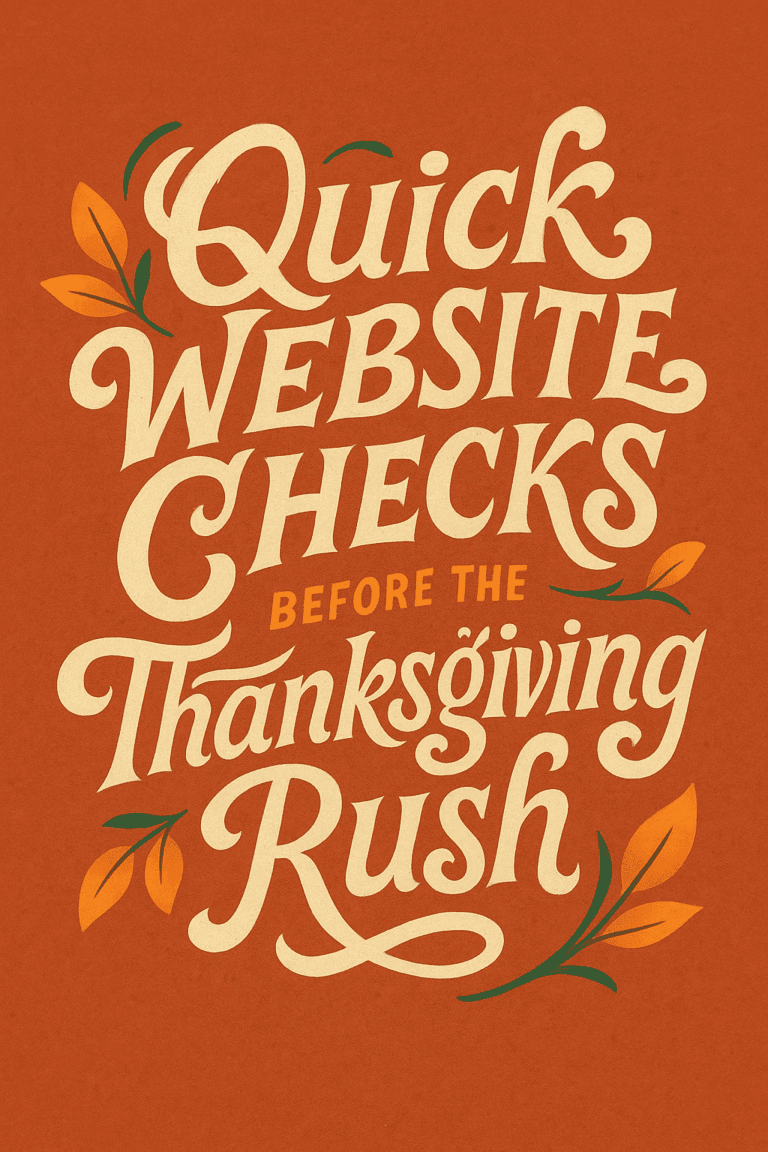
When you build or redesign a website, it’s easy to get lost in the details—choosing the perfect fonts, colors, or animations, or dreaming up a blog you swear you’ll update weekly. But here’s the reality: most visitors only care about a handful of pages. The rest? They skip right past them. They might click around a bit, but the pages that do the real work are the ones that matter most.
If your business website isn’t generating the calls, leads, or sales you expect, the problem might not be the entire site. It could be that the pages people actually visit aren’t doing their job effectively. Let’s dive into which pages matter, why they matter, and how to make them work harder for you.
What People Think Matters vs. What Actually Does
Many small businesses pour time and energy into elements like:
- A flashy homepage slider that cycles through images
- A carefully crafted “Our Mission” statement
- A blog with a couple of dusty posts from years ago
But visitors? They’re not here for that. They’re scanning your site in seconds, looking for answers to their burning questions:
- Can I trust this company?
- Do they have what I need?
- How much is this going to cost?
- How do I get in touch?
These questions drive user behavior, and the pages they visit reflect their search for clarity and direction. Let’s break down the pages they actually care about.
The Top Pages People Actually Visit
Data from website analytics and years of experience building high-performing sites point to a clear set of pages that attract the most attention. Here’s what they are and how to make them shine.
1) Homepage
Purpose: First impression, orientation, and quick filtering.
People don’t linger on homepages. They glance, scroll, and make a snap judgment about whether your site is worth their time. In those few seconds, they’re trying to figure out:
- What do you do?
- Where are you located?
- Are you legitimate?
- Should I keep exploring?
What matters most on this page:
- A clear headline that instantly communicates what you do and who you serve
- A simple, prominent call to action (e.g., “Get a Quote” or “See Our Work”)
- Visual cues of professionalism, like high-quality photos, trust badges, or client logos
- A clean, fast-loading design that doesn’t overwhelm
Mistake to avoid: Turning your homepage into a catch-all. If it tries to say everything, it says nothing. Keep it focused and guide visitors to the next step.
2) About Page
Purpose: Build trust and create a human connection.
The About page is one of the most visited pages on any business website. Why? People want to know who they’re dealing with. They’re not always interested in your company’s origin story or a list of awards—they want to feel confident in choosing you.
They’re looking for:
- A human face (photos of you or your team)
- An authentic voice (not corporate jargon)
- A reason to choose you over the competition
Tips to improve this page:
- Include a photo of your team, your workspace, or yourself to humanize your brand
- Write conversationally, like you’re talking to a friend
- Answer the question: Why should someone pick you over anyone else?
Mistake to avoid: Writing a long-winded essay. Keep it concise, friendly, and focused on the visitor’s needs.
3) Services Page
Purpose: Clearly show what you offer and make it easy to choose.
This is where the money is made. If visitors can’t quickly understand what you offer or what to do next, they’ll leave. A strong Services page is critical for conversions.
How to improve it:
- Break services into distinct sections or dedicated pages for clarity
- Use straightforward language (e.g., “Website Design” instead of “Digital Solutions”)
- Showcase examples or outcomes of your work
- Address common objections like timeline, price range, or deliverables
Bonus tip: Embed short case studies or testimonials directly on this page to build trust right where decisions are made.
Mistake to avoid: Being vague or overly technical. Clarity is king.
4) Contact Page
Purpose: Make it dead simple for people to reach you.
This one seems obvious, but it’s often neglected. A Contact page should remove all friction from the process of getting in touch.
People expect to see:
- A functional contact form
- A phone number and email address
- Your physical location (if relevant)
- Business hours (if applicable)
Other smart additions:
- A short message about when they can expect a response
- A link to your Google Business Profile
- A friendly thank-you message after form submission
Mistake to avoid: Making the Contact page the only way to reach you. Sprinkle calls to action (like “Contact Us” buttons) throughout your site.
5) Portfolio or Work Samples Page
Purpose: Prove your skills with tangible examples.
This is your “show, don’t tell” page. Especially for businesses in design, trades, or professional services, a portfolio page lets your work speak for itself.
Strong portfolio pages include:
- Before-and-after photos (if applicable)
- Descriptions of the challenge and solution for each project
- Filters for industry or client type
- Consistent, professional visuals
Pro tip: Highlight results, not just visuals. For example, “This website redesign increased client leads by 50%.”
Mistake to avoid: Dumping a bunch of projects without context or explanation.
6) FAQ Page
Purpose: Address objections and build confidence.
An FAQ page isn’t just about answering questions—it’s about removing doubts that might stop someone from taking the next step.
Topics to cover:
- Your process and timeline
- Payment or pricing structure
- What’s included (and what’s not)
- Guarantees or warranties
- What sets you apart from competitors
Smart move: Write questions in the language your customers use, not industry jargon.
Mistake to avoid: Using the FAQ as a catch-all for random information that doesn’t fit elsewhere.
7) Pricing or Packages Page
Purpose: Set expectations and prequalify leads.
Even if you don’t list exact prices, visitors want a sense of the investment. A clear Pricing page saves time for both you and your potential clients.
What works well:
- Clear package names with detailed inclusions
- Price ranges (e.g., “Most projects start at $2,000”)
- Factors that affect pricing (timeline, scope, complexity)
- A clear next step, like “Request a Quote” or “Book a Call”
Mistake to avoid: Hiding pricing behind vague terms like “affordable” or requiring too many clicks to get answers.
8) Testimonials or Reviews Page
Purpose: Let your customers’ words build trust.
While individual testimonials sprinkled across your site drive conversions, some visitors will seek out a dedicated page of reviews for reassurance.
Include:
- Photos or logos (with permission)
- Specific results or benefits clients experienced
- Names, titles, and companies (with permission)
Even better: Add video or audio testimonials for extra authenticity.
Mistake to avoid: Using generic reviews like “They were great!”—they feel inauthentic and don’t add value.
What About Blog Posts?
Yes, blog posts get traffic, but not the way you might expect. Visitors usually land on them via search engines like Google, not by browsing your site’s menu. This means:
- Blog posts are entry points, not final destinations
- They should guide readers toward your services with clear calls to action
- They perform best when answering specific questions your audience is searching for
Keep blogging, but make sure each post links back to your core service pages with relevant calls to action.
Pages People Ignore or Rarely Visit
Not every page on your site is a star player. Here are some common pages that get minimal traffic:
- Terms and Conditions: Only needed for legal purposes
- Privacy Policy: Important but not a conversion driver
- Mission Statement: Rarely visited unless integrated into the About page
- Careers Page: Only relevant if you’re actively hiring
- Blog Home Page: Most visitors enter via specific posts
- Archives, Categories, or Tags: Rarely used by real users
These pages don’t need prominent placement. Tuck them into your footer to keep your navigation focused on what drives results.
How to Know Which Pages Your Visitors Look At
Don’t rely on assumptions—use data to guide your decisions. Tools like Google Analytics or Plausible can show you:
- Which pages get the most visits
- Bounce rates (where people leave quickly)
- Time spent on each page
- Click-through paths to understand user flow
You might be surprised to find that your “Our Values” page has barely been touched, while your FAQ or Portfolio page is doing the heavy lifting.
How to Make These Pages Work Harder
Knowing which pages matter is half the battle. Here’s how to optimize them for better results:
1) Add Clear Calls to Action
Every key page should lead visitors to the next step. Whether it’s a button, a form, or a “Book a Call” link, don’t assume people will find their way to your Contact page on their own.
2) Make the Copy Skim-Friendly
People don’t read—they scan. Use:
- Short paragraphs
- Bullet points for key information
- Bolded phrases to highlight important points
Help visitors find what they need quickly.
3) Show Proof
On your About, Services, and Portfolio pages, include trust-building elements like:
- Testimonials from happy clients
- Before-and-after visuals
- Short case studies
- Stats or results (e.g., “Increased sales by 30%”)
Social proof turns skeptics into believers.
4) Keep It Updated
Outdated information erodes trust. A blog post from 2021 or an About page mentioning a former employee sends the wrong signal. Regularly review and refresh your content.
5) Design for Clarity
Good design isn’t about following trends—it’s about making things easy to understand. Focus on:
- Proper spacing for readability
- Clear, hierarchical headings
- Mobile responsiveness
- Legible fonts and high contrast
Cut Through the Noise
Most business websites are cluttered with fluff—pages nobody reads, menus that confuse, and text that says too much while answering too little. But when you focus on the pages people actually visit and optimize them for clarity and action, you’ll see better results:
- More leads
- More calls
- Less confusion
- Higher trust
At Graticle Design, we help our clients cut through the noise. We don’t just make websites look good—we make them work. If you’re unsure which pages on your site are performing (or which ones are just taking up space), we can help.





